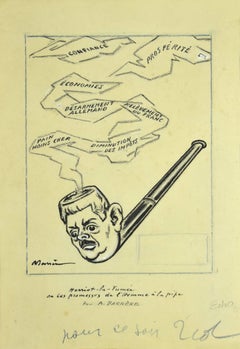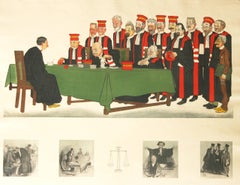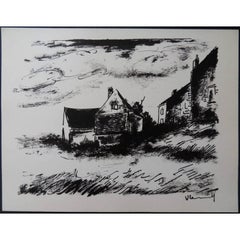Adrien Barrère Art
to
1
1
1
1
1
1
Overall Height
to
Overall Width
to
1
2
1
1
1
1
1
2
1
2
6,935
3,285
2,514
1,213
1
1
Artist: Adrien Barrère
Pipe - Original Pencil by Adrien Barrère - Early 20th Century
By Adrien Barrère 1
Located in Roma, IT
Pipe is an original drawing in pencil and mixed media on creamy paper realized by Adrien Barrère (1874-1931).
Hand-signed on bottom.
The state of pres...
Category
Early 20th Century Modern Adrien Barrère Art
Materials
Pencil
Passing the Bar
By Adrien Barrère 1
Located in Paonia, CO
artist: Adrien Barrere (1877-1931)
title: Passing the Bar
medium: Lithograph
paper size: 19.75 x 25.50
image size: 18 x 24.25
French caricaturist...
Category
1930s Adrien Barrère Art
Materials
Lithograph
Related Items
Hand of Africa - Mandela, Former South African President, Signed Artwork, Hand
By Nelson Mandela
Located in Knowle Lane, Cranleigh
Nelson Mandela, Hand of Africa, Signed Limited Edition Lithograph
Many people are unaware that Nelson Mandela turned his hand to art in his 80's as a way of leaving a legacy for his ...
Category
Early 2000s Contemporary Adrien Barrère Art
Materials
Lithograph
Maurice de Vlaminck - House in Rueil - Original Lithograph
By Maurice de Vlaminck
Located in Collonge Bellerive, Geneve, CH
Maurice de Vlaminck
Original Lithograph
Signed in the plate
1958
Title: House in Beauce
Dimensions: 22 x 27 cm
Reference: Catalogue raisonné Walterskirchen 275
Condition : Excellent
Maurice de Vlaminck (1876 - 1958)
Maurice was three years old when his family moved from Paris to Vésinet. He first pursued the same musical career as his parents, who were both musicians, leaving his home as a trained double-bass player in 1892 to move to Chatou near Versailles. After absolving his military service in Vitré Maurice Vlaminck worked as a musician until he accidentally met André Derain in 1900.
It was Derain who kindled Vlaminck's artistic ambitions. He decided to become a painter and rented an old hut in which he and Derain shared a studio. A crucial turning point in Vlaminck's artistic development was a visit to a van Gogh exhibition...
Category
1950s Impressionist Adrien Barrère Art
Materials
Lithograph
H 8.67 in W 10.63 in D 0.04 in
Mon Colonel
By Auguste Chabaud
Located in London, GB
'Mon Colonel', pencil and crayon on paper, by noted French artist, Auguste Chabaud (circa 1914-1918). A delightfully simple drawing of a French Army colonel in profile along with clo...
Category
1910s Modern Adrien Barrère Art
Materials
Paper, Crayon, Pencil
Male Torso
By John Koch
Located in London, GB
Pencil, coloured pencil and chalk on paper, titled (lower left), signed (lower right), 31cm x 46cm, (51cm x 68cm framed).
John Koch was an American painter and teacher, and an impo...
Category
1950s American Modern Adrien Barrère Art
Materials
Paper, Chalk, Pencil, Color Pencil
Homme barbu couronné feuilles de vigne
By Pablo Picasso
Located in Palo Alto, CA
Created in 1962, this linocut on Arches wove paper is hand-signed by Pablo Picasso (Malaga, 1881 - Mougins, 1973) in pencil in the lower right margin and is numbered from the edition of 50 in the lower left margin.
Catalogue Raisonné:
Pablo Picasso Homme barbu couronné feuilles de vigne...
Category
1960s Modern Adrien Barrère Art
Materials
Lithograph
Blue Face from the Brushstroke Figures Series
By Roy Lichtenstein
Located in Miami, FL
Lithograph, waxtype woodcut and screenprint on 638-g/m cold-pressed Saunders Waterford Paper. From the "Brushstroke Figures" series, 1989. Hand signed rf Lichtenstein, dated ('89) a...
Category
1980s Contemporary Adrien Barrère Art
Materials
Lithograph, Screen, Woodcut
Free Shipping
H 53.7 in W 38.9 in
"Manhattan Bridge" NYC American Scene Modernism Watercolor WPA Urban Realism
By Reginald Marsh
Located in New York, NY
Reginald Marsh "Manhattan Bridge" NYC American Scene Modernism Watercolor WPA Urban Realism, 20 x 14 inches. Watercolor and pencil on paper, 1938. Signed...
Category
1930s American Modern Adrien Barrère Art
Materials
Paper, Watercolor, Pencil
La Capeline de Paille d'Italie (The Italian Straw Hat).
By Henri Matisse
Located in Storrs, CT
La Capeline de Paille d'Italie (The Italian Straw Hat). 1923. Lithograph. Duthuit 430. 17 3/4 x 15 3/4 (sheet 23 1/8 x 17 7/8). Trial proof, apart fr...
Category
Early 20th Century Modern Adrien Barrère Art
Materials
Lithograph
H 30.5 in W 26.13 in D 1.5 in
The Archibald Russell.
By Arthur John Trevor Briscoe
Located in Storrs, CT
The Archibald Russell. 1935. Pencil and watercolour on watercolour board. 20 7/8 x 28 5/8. Mat line from a previous mount; otherwise excellent condition. Signed and dated in ink, low...
Category
1930s Modern Adrien Barrère Art
Materials
Watercolor, Pencil
Blanche Grambs, (Young Bird with Ferns)
Located in New York, NY
Blanche Grambs, whose career started with the WPA, was an extremely skilled draftsperson.
Her birds are masterful. This charming piece places the yooun...
Category
1970s American Modern Adrien Barrère Art
Materials
Pencil
"Lorenzaccio" by Alphonse Mucha from Les Maitres de l'Affiche
By Alphonse Mucha
Located in Hinsdale, IL
Alphonse Mucha
"Lorenzaccio, a play in five acts and an epilogue by Alfred de Museet"
Plate #114
Image Size: 15" x 11"
1896
Alphonse Mucha was born in Southern Moravia on July 24, 1860. At the age of seventeen the artist left his home, to work as a painter of stage decorations...
Category
1890s Art Nouveau Adrien Barrère Art
Materials
Lithograph
H 23 in W 14.5 in D 1 in
Boston Abstract Expressionist Hyman Bloom Original Pencil Drawing Martin Sumers
By Hyman Bloom
Located in Surfside, FL
This is a unique artwork. This is an original Hyman Bloom drawing of fellow artist and his very good friend Martin Sumers.I believe this was drawn at the “variations of a theme” at Sumers gallery in NYC. The last two photos show a poster and a card from their shows. it is not included in this listing, it is just for provenance.
Provenance: Acquired from the Sumers estate collection.
Hyman Bloom (March 29, 1913 – August 26, 2009) was a Latvian-born American painter. His work was influenced by his Jewish heritage and Eastern religions as well as by artists including Altdorfer, Grünewald, Caravaggio, Rembrandt, Blake, Bresdin, James Ensor and Chaim Soutine. He first came to prominence when his work was included in the 1942 Museum of Modern Art exhibition "Americans 1942 -- 18 Artists from 9 States". MoMA purchased 2 paintings from the exhibition and Time magazine singled him out as a "striking discovery" in their exhibition review.
His work was selected for both the 1948 and 1950 Venice Biennale exhibitions and his 1954 retrospective traveled from Boston's Institute of Contemporary Art to the Albright Gallery and the de Young Museum before closing out at The Whitney Museum of American Art in 1955. In a 1954 interview with Yale art professor Bernard Chaet, Willem de Kooning indicated that he and Jackson Pollock both considered Bloom to be “America’s first abstract expressionist”, a label that Bloom would disavow. Starting in the mid 1950s his work began to shift more towards works on paper and he exclusively focused on drawing throughout the 1960s, returning to painting in 1971. He continued both drawing and painting until his death in 2009 at the age of 9
Hyman Bloom (né Melamed) was born into an orthodox Jewish family in the tiny Jewish village of Brunavišķi in what is now Latvia, then part of the Russian Empire
At a young age Bloom planned to become a rabbi, but his family could not find a suitable teacher. In the eighth grade he received a scholarship to a program for gifted high school students at the Museum of Fine Arts. He attended the Boston High School of Commerce, which was near the museum. He also took art classes at the West End Community Center, a settlement house. The classes were taught by Harold Zimmerman, a student at the School of the Museum of Fine Arts, who also taught the young Jack Levine at another settlement house in Roxbury. When Bloom was fifteen, he and Levine began studying with a well-known Harvard art professor, Denman Ross, who rented a studio for the purpose and paid the boys a weekly stipend to enable them to continue their studies rather than take jobs to support their families.
He took Bloom and Levine on a field trip to the Museum of Modern Art in New York, where Bloom was impressed by the work of Rouault and Soutine and began experimenting with their expressive painting styles.
In the 1930s Bloom worked sporadically for the Public Works of Art Project and the Federal Art Project (WPA), He shared a studio in the South End with Levine and another artist, Betty Chase. It was during this period that he developed a lifelong interest in Eastern philosophy and music, and in Theosophy.
He first received national attention in 1942 when thirteen of his paintings were included in the Museum of Modern Art (MoMA) exhibition Americans 1942: 18 Artists from 9 States, curated by Dorothy Miller. MoMA purchased two of his paintings from that exhibition, and he was featured in Time magazine. The titles of his paintings in the exhibition reflect some of his recurring themes. Two were titled The Synagogue, another, Jew with the Torah; Bloom was actually criticized by one reviewer for including "stereotypical" Jewish images. He also had two paintings titled The Christmas Tree, and another titled The Chandelier, both subjects he returned to repeatedly. Another, Skeleton (c. 1936), was followed by a series of cadaver paintings in the forties, and The Fish (c. 1936) was one of many paintings and drawings of fish he created over the course of his career.
Bloom was associated at first with the growing Abstract Expressionist movement. Willem de Kooning and Jackson Pollock, who first saw Bloom's work at the MoMA exhibition, considered Bloom "the first Abstract Expressionist artist in America." In 1950 he was chosen, along with the likes of de Kooning, Pollock, and Arshile Gorky, to represent the United States at the Venice Biennale. That same year Elaine de Kooning wrote about Bloom in ARTnews, noting that in paintings such as The Harpies, his work approached total abstraction: "the whole impact is carried in the boiling action of the pigment". In 1951 Thomas B. Hess reproduced Bloom's Archaeological Treasure in his first book, Abstract Painting: Background and American Phase, along with works by Picasso, Pollock, and others. Both de Kooning and Hess remarked on Bloom's expressive paint handling, a key characteristic of Abstract Expressionist painting.
As abstract expressionism dominated the American art world, Bloom became disenchanted with it, calling it "emotional catharsis, with no intellectual basis." In addition, instead of moving to New York to pursue his career, he opted to stay in Boston. As a result he fell out of favor with critics and never achieved the kind of fame that Pollock and others did. He disliked self-promotion and never placed much value on critical acclaim.
Many of Bloom's paintings feature rabbis, usually holding the Torah. According to Bloom, his intentions were more artistic than religious. He began questioning his Jewish faith early in life, and painted rabbis, he claimed, because that was what he knew. Over the course of his career he produced dozens of paintings of rabbis...
Category
20th Century Modern Adrien Barrère Art
Materials
Paper, Pencil
Adrien Barrère art for sale on 1stDibs.
Find a wide variety of authentic Adrien Barrère art available for sale on 1stDibs. You can also browse by medium to find art by Adrien Barrère in lithograph, pencil and more. Much of the original work by this artist or collective was created during the 20th century and is mostly associated with the modern style. Not every interior allows for large Adrien Barrère art, so small editions measuring 13 inches across are available. Customers who are interested in this artist might also find the work of Charles Joseph Traviès, Chas Laborde, and Philibert-Louis Debucourt. Adrien Barrère art prices can differ depending upon medium, time period and other attributes. On 1stDibs, the price for these items starts at $198 and tops out at $295, while the average work can sell for $246.
Artists Similar to Adrien Barrère
Robert Sargent Austin, R.A., P.R.E., P.R.W.S.



